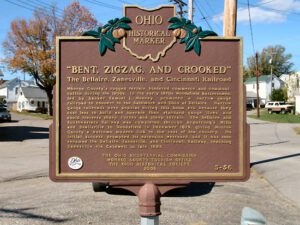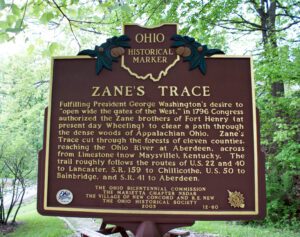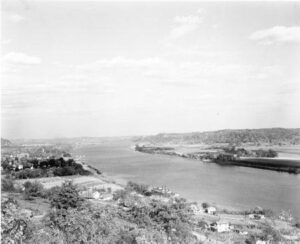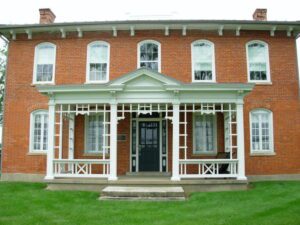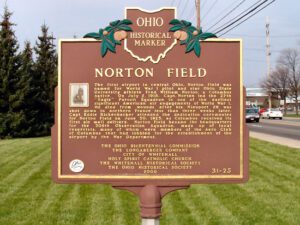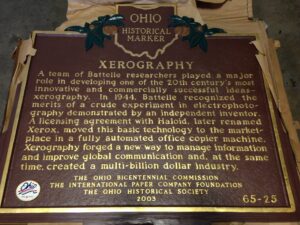, OH
Monroe County’s rugged terrain hindered commerce and communication during the 1800s. In the early 1870s Woodsfield businessmen, led by banker Samuel L. Mooney, promoted a narrow-gauge railroad to connect to the Baltimore and Ohio at Bellaire. Narrow gauge railroads were popular during this boom era because they cost less to build and operate than standard-gauge lines and could traverse sharp curves and steep terrain. The Bellaire and Southwestern Railway was completed through Armstrong’s Mills and Beallsville to Woodsfield in December 1879, giving Monroe County a welcome modern link to the rest of the country. Its initial success prompted its extension westward, and it was soon renamed the Bellaire, Zanesville, and Cincinnati Railway, reaching Zanesville via Caldwell in late 1883.
, OH
On July 18, 1907, Dr. Lee deForest broadcast the first ship-to-shore radio message from the steam yacht Thelma. The communication provided quick, accurate race results of the Annual Inter-Lakes Yachting Association (I-LYA) Regatta. Frank E. Butler, a Monroeville, Ohio, native and assistant to deForest, was stationed in the pavilion at Fox’s Dock (known today as The Jet Express Dock) and received the radio transmission. The creation of the vacuum tube by deForest permitted the rapid development of radio and eventually television. The inventor disliked the existing term “wireless,” and chose a new moniker — “radio.” On this site wireless-transmission radio broadcasting was born.
, OH
Fulfilling President George Washington’s desire to “open wide the gates of the West,” in 1796 Congress authorized the Zane brothers of Fort Henry (at present day Wheeling) to clear a path through the dense woods of Appalachian Ohio. Zane’s Trace cut through the forests of eleven counties, reaching the Ohio River at Aberdeen, across from Limestone (now Maysville), Kentucky. The trail roughly follows the routes of U.S. 22 and 40 to Lancaster, S. R. 159 to Chillicothe, U.S. 50 to Bainbridge, and S. R. 41 to Aberdeen.
, OH
The Ohio River, the southeast border of Gallia County, played a significant role in the development of Gallipolis and Gallia County. One of the state’s first thoroughfares, this waterway enabled pioneers to settle in what was known as the Northwest Territory. On October 17, 1790, approximately 500 French immigrants arrived in Gallipolis, traveling by flatboats from Pittsburgh, and settled in log cabins in what is now City Park, in the heart of Gallipolis. This established the second oldest permanent settlement in the territory. The settlers relied on the River for communication, commerce, and transportation, and the River brought postal service to Gallipolis in 1794. As local business and river trade developed in the 1800s, Gallipolis became a thriving port. The scenic Ohio River is an important inland waterway, providing transportation for many commodities between major cities. The River also provides recreational opportunities for both visitors and residents, including water sports, fishing, and boating.
, OH
Known as the “Halfway House,” the Gooding House and Tavern was built by George B. Gooding halfway between the towns of Worthington and Delaware in 1827. Its location was influenced by construction of the Columbus and Sandusky Turnpike that was chartered by the State of Ohio the year before. Also known as the “Mud Pike,” the turnpike was slow and difficult for travelers and could take nearly a day to travel 10 miles. The Gooding House was the perfect place for stagecoach drivers to change teams of horses and for travelers to rest and have refreshments. George Gooding also prospered as a farmer with over 1,000 acres of land. This stately brick farmstead remained in the Gooding family for 175 years with each succeeding generation adding its imprint on the property. The Gooding House and Tavern was listed on the National Register of Historic Places in 2005 and restored in 2007.
, OH
The first airport in central Ohio, Norton Field was named for World War I pilot and star Ohio State University athlete Fred William Norton, a Columbus native. On July 2, 1918, Capt. Norton led the 27th “Eagle” Pursuit Squadron in one of the earliest significant American air engagements of World War I. He died from wounds after his Nieuport 28 was shot down in northern France less than three weeks later. Capt. Eddie Rickenbacker attended the dedication ceremonies for Norton Field on June 30, 1923, as Columbus received its first air mail delivery. Norton Field became the headquarters for the 308th Observation Squadron, made up of local reservists, many of whom were members of the Aero Club of Columbus that had lobbied for the establishment of the airport by the War Department.
, OH
A team of Battelle researchers played a major role in developing one of the 20th century’s most innovative and commercially successful ideas–xerography. In 1944, Battelle recognized the merits of a crude experiment in electrophotography demonstrated by an independent inventor. A licensing agreement with Haloid, later renamed Xerox, moved this basic technology to the marketplace in a fully automated office copier machine. Xerography forged a new way to manage information and improve global communication and, at the same time created a multi-billion dollar industry.


